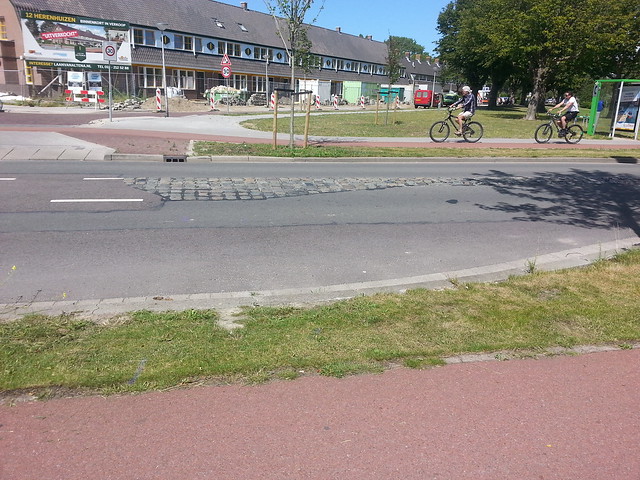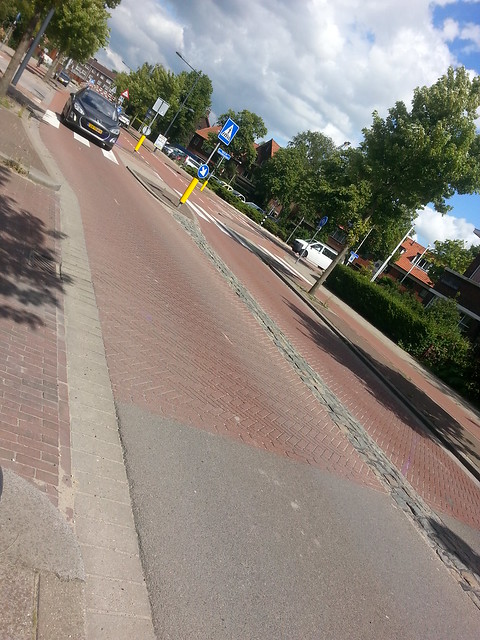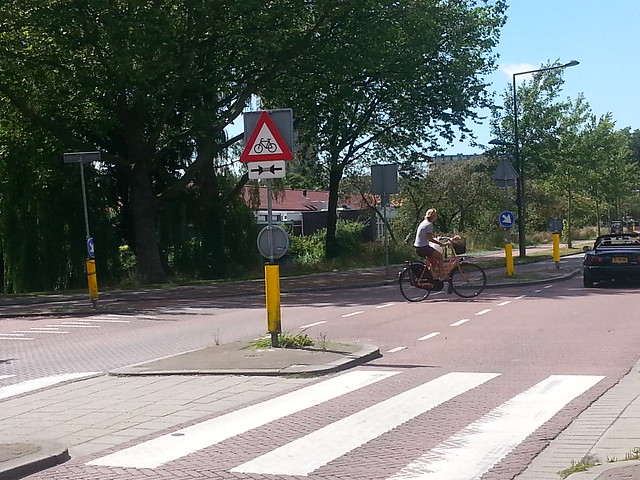Ruys de Beerenbroukstraat (Anna)
Ruys de Beerenbroekstraat
Ruys de Beerenbroukstraat is an urban distributor road with one lane of car traffic in each direction.
It has one way cycle tracks and parking on each side, as well as sidewalks and trees that occasionally interlude the parking. It connects to Princess Beatrixlaan to the west and turns into Kampveldeweg to the east, where it connects into Wateringsevest.
Functionality
Ruys de Beerenbrouckstraat in Delft is the only East-West thru road within 1 km, so its main functionality is traffic distribution, that is, transporting a considerable amount of vehicles between the neighborhoods of northwest Delft and the north-south main roads it crosses — Princess Beatrixlaan, a long urban flow road leading to Rijswijk and the western part of The Hague, and Wateringsvest, which is part of the Delft central ring and connects to the A13 freeway.
However, since it goes through a residential neighborhood, it also has a residential access function. That means that the people living there do not want it to be a noisy and unsafe street. Pedestrians are also crossing this street frequently because they live nearby, which makes safety even more important. The older, eastern part of the street was built in an era in which driving was rare, and so it has no off-street parking. Providing parking for residents is therefore one of the road’s functions.
The street therefore has a mixed functionality, which called for a new design. Initially the municipality of Delft wanted the speed limit to be 40 km/h road, right in between the usual 30km/h used for local access roads and the 50km/h used for distributor roads. However this was not allowed, because according to the recognizability principles of the Dutch, the only speed limits allowed in urban areas are 15 (in woonerven), 30 (access streets), 50 (distributor streets), and 70 km/h (major flow roads). Furthermore, the necessary distributor function precluded designating it as a local access street, so it had to be designated as a distributor road and given a legal speed limit of 50 km/h. Regardless, Ruys de Beerenbroekstraat was designed to get drivers to go 40 km/h even though legal speed limit is 50. The design works; in practice, cars go about 45 km/h (while on most 50 km/h roads, they go 55).
Speed Control and Recognizability
Here is an image of part of the cross section of the street (taken from a refuge Island):
Figure 1
As can be seen from the image above, one thing that has been done to make the street safer was to insert a median between the two car lanes. The median is made of gray cobbles and has a slight vertical elevation, but it can still be mounted by buses or larger vehicles if needed. The median is a major safety feature because it narrows the travel lanes, which automatically causes drivers to slow down and drive more carefully without having to be shown a speed limit sign.
This median spans the entire length of Ruys de Beerenbroukstraat. For one very short segment (near the CI supermarket), the street gets a little wider, so in order to compensate, the median was widened as well, in order to maintain the same narrowness:
Figure 2
The next thing that improves safety, especially for pedestrians, is the refuge island mentioned earlier. There are several crossings (5) on the street, so that pedestrians have many opportunities to cross safely and are less tempted to jay-walk on this street with heavy traffic. Here is an image of a car yielding to a woman who is crossing the street:
Figure 3
A refuge island is advantageous for pedestrians because they no longer have to wait for two cars (traveling in opposite directions) to stop simultaneously to allow for safe crossing. Even more importantly, there is no risk of the pedestrian getting “stuck” in the middle of traffic due to only one car yielding, which is a stressful and unsafe situation. The refuge island also narrows the road significantly. The Dutch never have a pedestrian crossing more than two lanes of traffic at a time, and wherever possible attempt to reduce that to crossing only one lane at a time, so this is common practice. In the city of Delft, there isn’t a single unsignalized crossing where pedestrians have to cross more than one lane at a time.
Another thing you can see in Figure 3 is blue triangular signs on either side of the refuge island, alerting cars that there is a crossing in that location.
That is not the only thing that grabs the attention of drivers however; as is visible in the picture below (Figure 4), the crossing (and several feet past each side of the crossing) is paved with red bricks, but elsewhere the street is made of regular gray asphalt.
These brick crossings were present at all but one crossing on Ruy de Beerenbroekstraat. The different look of the red brick and the different, slightly rougher feel of driving over the brick are supposed to alert the driver that they are entering a different zone, a zone in which pedestrians dominate and where cyclists may be crossing the street. Brick paving is typically used in areas where cars are meant to drive slower, so the brick used at these crossings is meant to help the driver recognize that what is expected of them is to be attentive, drive slower,and be ready to stop for a pedestrian.
Figure 4
At least two of the crosswalks along Ruy de Beerenbrowkstraat were slightly raised, providing for some vertical deflection, slowing cars down a little bit, and protecting pedestrians (unfortunately this elevation is not visible on the pictures I took, but look to Ryan Cullen’s blog post for more images and a detailed description on these exact speedbumps).
Other attention-getters on this street included several “watch for bicycle” (Figure 5) and “pedestrian crossing” signs mentioned earlier (Figure 3 and 4):
Figure 5
Figure 6
Homogeneity
Before its new design, Ruys de Beerenbroekstraat had bike lanes. As you can see in Figure 6 above, it how has cycle tracks that are raised and thus protected from motorized vehicle traffic by the curb, parked cars, and trees. This is congruent with the latest (2006) Dutch guidelines which state that while bike lanes are fine in situations where there are 1 + 1 lanes of traffic without parking, if there is the same configuration (two lanes of traffic, with one lane in each direction) with parking (as is the case with Ruys de Beerenbroekstraat), then there should be a cycle track.
Conclusion
When I visited at 3.30pm, the street was very, very busy, but nonetheless cars offered to yield to me very frequently (if not always), even when I was just taking pictures and did not have the intention to cross. Overall, while as a cyclist and especially as a crossing pedestrian you still need to pay attention, it has enough features that make is safe and relatively stress-free.





